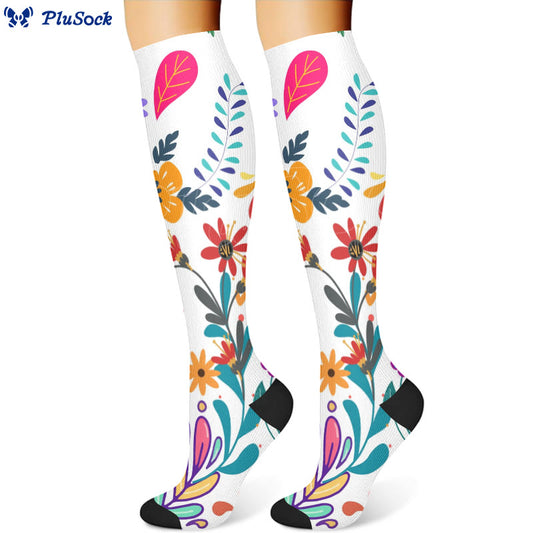
But how exactly does a women’s compression sock work? And why has it become a go-to wellness accessory for women from all walks of life? This article takes an in-depth look at how compression socks support circulation and contribute to lasting comfort.

Understanding Women’s Compression Socks
A women’s compression sock is a specially designed garment that applies gentle, graduated pressure to the foot, ankle, and calf. Unlike regular socks, which focus only on warmth and style, compression socks are engineered to assist the body’s natural blood circulation process.
The term “graduated compression” refers to the way these socks exert the most pressure at the ankle and gradually lessen as they move up the leg. This strategic design helps combat the effects of gravity, making it easier for veins to carry blood back to the heart.
How Circulation Works — and Why It Matters
The circulatory system is responsible for transporting oxygen-rich blood from the heart to the rest of the body and then bringing deoxygenated blood back. For the lower limbs, this return journey is a bit more challenging due to the effects of gravity. When you stand or sit for long periods, blood can pool in the lower legs, causing swelling, fatigue, and discomfort.
This is particularly true for women, who may experience added pressure on leg veins during pregnancy, hormonal changes, or due to prolonged periods of inactivity or overexertion. Poor circulation can lead to varicose veins, spider veins, or more serious conditions like deep vein thrombosis (DVT).
Women’s compression socks work by supporting the veins and muscles in the lower legs, helping to push blood upward and prevent it from pooling.
The Science of Compression: How It Boosts Circulation
Compression socks improve blood flow by mimicking the natural pumping action of muscles. When worn properly, they:
Apply external pressure to the surface veins, arteries, and muscles.
Reduce the diameter of distended veins, which increases blood flow velocity.
Support venous valves to function more efficiently, preventing backflow.
Encourage lymphatic drainage, reducing fluid retention and swelling.
By increasing circulation, compression socks reduce the feeling of heavy, tired legs and lower the risk of blood clots. They essentially “wake up” the circulatory system and give it an added push, especially when the legs aren’t moving much.
How Compression Socks Enhance Comfort for Women
Aside from the physiological benefits, compression socks significantly improve daily comfort in several ways:
1. Reduced Swelling and Inflammation
Women who experience swelling in their feet and ankles due to pregnancy, prolonged sitting or standing, or hormonal fluctuations find immediate relief with compression socks. By minimizing fluid buildup in the tissues, these socks help legs feel lighter and more energized.
2. Decreased Leg and Foot Fatigue
Whether you're walking around a hospital as a nurse, running errands all day, or spending hours in a chair at a desk job, leg fatigue can take a toll. Compression socks reduce muscle vibration, which often contributes to soreness and tiredness. They also help your legs recover more quickly after exertion.
3. Alleviation of Varicose and Spider Veins
Varicose veins are not only a cosmetic concern but also a source of discomfort for many women. Compression socks help prevent and manage varicose and spider veins by supporting weakened or enlarged veins, thus improving venous return and relieving associated pain or heaviness.
4. Support During Pregnancy
Pregnancy increases blood volume and places additional pressure on the veins, making women more prone to swelling, varicose veins, and leg cramps. Maternity compression socks are specifically designed to provide gentle support without constriction, promoting healthy blood flow and reducing discomfort.
5. Travel and Long-Distance Comfort
Long flights or road trips often leave women with sore, swollen legs. Compression socks prevent blood from pooling during periods of inactivity and significantly lower the risk of travel-related DVT. Many female travelers report that compression socks make travel more comfortable and less tiring.
Who Should Consider Wearing Women’s Compression Socks?
Women across various age groups and professions can benefit from incorporating compression socks into their daily routine, including:
Pregnant women experiencing leg swelling or discomfort.
Nurses and healthcare workers on their feet for extended hours.
Office workers and students who sit for prolonged periods.
Athletes and runners seeking muscle support and faster recovery.
Travelers spending long hours in planes or cars.
Women with diabetes, varicose veins, or circulation issues.
Choosing the Right Compression Sock
To get the most benefit, it's important to choose the right compression sock. Here’s what to consider:
Compression Level:
Mild (8–15 mmHg): For everyday comfort and prevention.
Moderate (15–20 mmHg): For mild swelling or travel.
Firm (20–30 mmHg): For varicose veins or medical conditions.
Length: Knee-high is most common, but thigh-high and full-leg options are available.
Material: Look for breathable, moisture-wicking fabrics for all-day comfort.
Fit: A proper fit is essential. Measure your ankle, calf, and sometimes thigh circumference to find the right size.
It’s recommended to consult a doctor before wearing higher compression levels (above 20 mmHg), especially if you have underlying health conditions.
Conclusion
A women’s compression sock is more than just a piece of clothing—it’s a health and wellness tool that offers real, tangible benefits. By improving blood circulation and providing lasting comfort, compression socks empower women to take better care of their legs, whether they’re working, traveling, exercising, or expecting.
From reducing swelling and leg fatigue to supporting vein health and enhancing daily performance, these simple garments can make a noticeable difference in how your legs feel throughout the day. As more women discover the benefits, compression socks are becoming an essential part of a healthy, active lifestyle—delivering comfort and care, one step at a time.